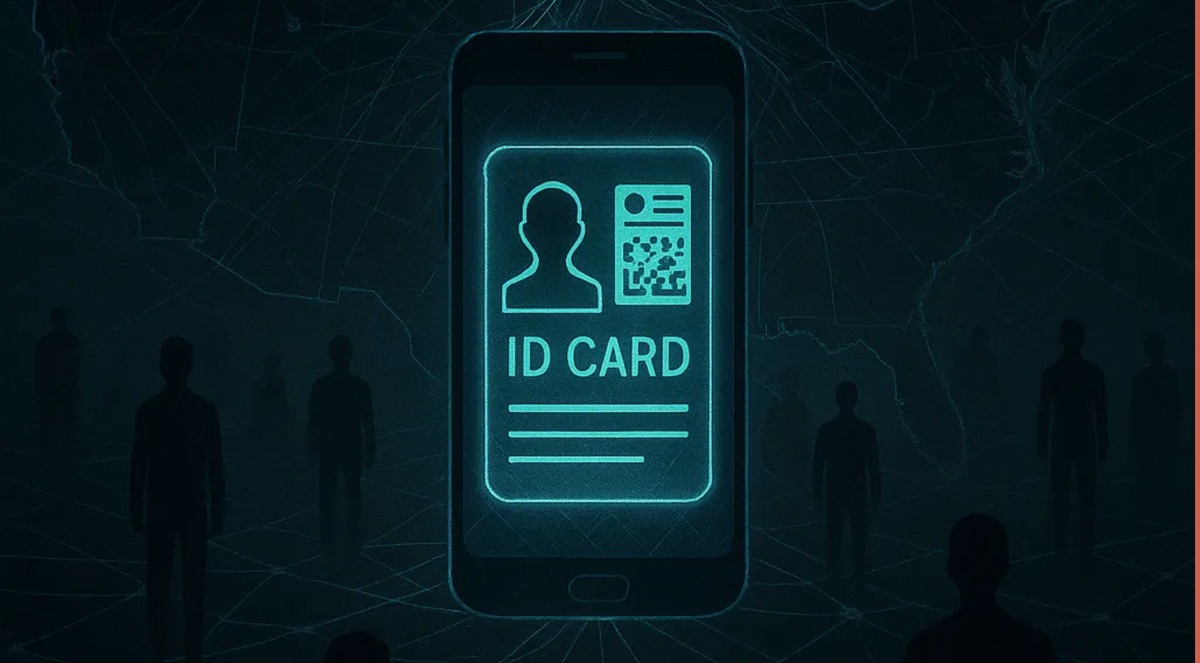100 tactics to Escape the Surveillance State
Activists and grassroots organizations have begun ramping up campaigns to educate residents and pressure lawmakers about the outright dangers of the Digital ID system.

It has finally arrived: The dreaded Digital ID. It has already been rolled out in various forms throughout140 countries and is fast approaching U.S. shores.
Personal Tech & Behaviour
1. Turn off Face ID and fingerprint unlock on your phone.
2. Delete or refuse to install government apps.
3. Delete or refuse to install health agency apps (e.g., CDC or state health department apps).
4. Stop using biometric check-ins at shops and airports when possible.
5. Refuse self-scan at checkouts that use cameras/biometrics.
6. Use cash for as many purchases as you can.
7. Keep and use a physical wallet with cash on hand.
8. Draw out small amounts of cash regularly and spend them.
9. Use pre-paid cash cards (that can be bought with cash) for some purchases.
10. Use an old/basic phone (feature phone) for calls and texts where feasible.
11. Use a separate smartphone for sensitive services and keep it minimal.
12. Use a burner or prepaid SIM bought with cash for activities you want unlinked.
13. Avoid “log in with” social sign-ins (Google/Facebook/Apple) where possible.
14. Use privacy-forward browsers and block trackers.
15. Install and use browser adblockers and anti-tracking extensions.
16. Use encrypted services for private messaging.
17. Use end-to-end encrypted email solutions where appropriate.
18. Limit social media sharing of identifying info (DOB, address, job).
19. Do not upload biometric photos (face scans) to apps or services unless essential.
20. Opt out of optional data-sharing consent boxes on websites.
21. Regularly check and revoke app permissions (camera, mic, location).
22. Turn off location services and Bluetooth when not needed.
23. Use separate email addresses for financial and social accounts.
24. Use strong, unique passwords and a reputable password manager.
25. Use two-factor authentication.
26. Back up important documents in physical form, not only cloud.
Financial & Consumer Actions
27. Boycott businesses that refuse to accept cash.
28. Publicly call out shops that go cashless; leave reviews and complaints.
29. Write formal complaints to cashless businesses and cc state consumer protection agencies or the FTC.
30. Bank with institutions that keep meaningful in-branch cash service.
31. Move some savings to local credit unions or community banks that accept cash and value privacy.
32. Use cash-to-gift-card services for certain online purchases.
33. Avoid companies that explicitly partner with ID-as-a-service providers.
34. Boycott specific vendors known for surveillance or ID contracts (e.g., facial recognition firms), research locally and act.
35. Divest from funds/companies that provide digital ID surveillance tech when possible.
36. Pressure retirement plans and fund managers to disclose holdings in ID vendors.
Civic & Political Actions
37. Sign petitions opposing mandatory digital ID.
38. Submit responses to federal or state agency consultations.
39. Write personalized letters to your congressional representative or senators explaining your concerns.
40. Meet your representative at town halls and insist on answers in writing.
41. Organize or attend town-hall or city council Q&As about digital ID.
42. Attend city council or county board meetings and ask questions about procurement and ID pilots.
43. Join public consultations and demand PIAs (Privacy Impact Assessments) and independent audits.
44. File Freedom of Information Act (FOIA) requests about digital ID pilots, contracts, and costs.
45. Ask for equity impact assessments to protect vulnerable groups.
46. Push for congressional hearings or resolutions on digital ID.
47. Support or lobby for bills that protect cash rights and limit compulsory digital ID.
48. Build relationships with sympathetic city council members, state legislators, or members of Congress and give them briefing packs.
49. Support candidates who oppose mandatory digital ID at election time.
50. Vote and encourage others to vote on these issues.
51. Organize letter-writing and phone-banking campaigns to representatives and agency officials.
52. Request public hearings on procurement decisions relating to ID systems.
53. Demand cost-benefit and risk analyses be published before any rollout.
Legal & Formal Resistance
54. File complaints to the FTC (Federal Trade Commission) or state attorneys general about privacy risks and data-sharing.
55. Request your employer to publish the legal basis for any identity checks and to provide non-digital alternatives.
56. Ask employers for a written policy on how I-9 or right-to-work checks are performed and how employees’ data is handled.
57. If you’re an employee, push your employer to oppose mandatory digital ID.
58. Support legal challenges, donate to or fundraise for lawsuits or judicial reviews.
59. Help crowdsource evidence (documents, policies) that could support litigation.
Community Organizing & Outreach
60. Hand out leaflets in your area explaining the risks.
61. Host local meetups to explain practical steps people can take.
62. Start or join a local community group focused on resisting digital ID.
63. Build a coalition with disability groups, privacy advocates, faith groups, and cash-reliant communities to broaden resistance.
64. Train volunteers on how to speak to neighbors about privacy and cash rights.
65. Set up community cash swaps or local barter networks.
66. Run workshops on digital hygiene and how to opt out of tracking.
67. Partner with small businesses to keep cash-acceptance visible.
Media, Messaging & Narrative Work
68. Write letters to local papers denouncing mandatory digital ID.
69. Produce short videos explaining risks and how to resist (shareable social clips).
70. Host a podcast interviewing experts, affected people, and whistleblowers.
71. Use social media to amplify stories of people harmed by digital ID pilots.
72. Make infographics showing vendor links, money flows, and conflicts of interest.
73. Run targeted ad campaigns to raise local awareness.
74. Pitch investigative journalists with FOIA findings.
Direct Economic & Corporate Pressure
75. Start a public petition to get a company to drop its digital-only policy.
76. Organize coordinated boycotts of companies that partner with ID vendors.
77. Contact company shareholders and ask questions at AGMs about ID contracts.
78. File consumer complaints with state attorneys general or the FTC against firms that refuse reasonable alternatives.
79. Pressure procurement officers at city councils or state agencies to refuse contracts with vendor-lock clauses.
80. Publicly shame companies on social platforms and review sites for surveillance partnerships.
81. Support competitors that offer privacy-affirming services.
Allies & Funding
82. Donate to and support grassroots projects/campaigns fighting surveillance: Electronic Frontier Foundation (EFF), Fight for the Future, or local privacy groups.
83. Fund or crowdfund legal action and investigations.
84. Build alliances with civil-society groups working on housing, health, finance, and inclusion, show them how ID affects their members.
85. Recruit sympathetic lawyers, academics, and technologists to produce legal briefs and technical critiques.
86. Encourage local businesses to join a “cash-friendly” charter.
Creative Disruption
87. Wear badges/stickers that say “I refuse mandatory digital ID” at public events.
88. Organize peaceful demonstrations outside city halls, state capitols, or federal buildings.
89. Stunt actions that are lawful and headline-grabbing (letter drops, flash-mob info sessions).
90. Stage public teach-ins or film screenings about surveillance and privacy.
91. Join regular protests organized by privacy advocacy groups like the EFF or local chapters.
Education & Long-Term Strategy
92. Educate youth and students: Partner with schools, homeschool groups, or youth organizations to teach digital privacy basics and the risks of mandatory ID systems.
93. Create toolkits for businesses: Develop and distribute guides for small businesses on how to resist digital ID mandates while staying compliant with laws like I-9 requirements.
94. Monitor state-level legislation: Track bills in state legislatures related to digital ID or surveillance; alert networks when action is needed and submit testimony.
95. Build alternative ID systems: Support or contribute to decentralized, privacy-preserving identity projects (e.g., blockchain-based or community-verified IDs) as opt-outs.
96. Archive surveillance vendor info: Create public databases or wikis documenting companies involved in digital ID contracts, their lobbying, and weaknesses for activists to use.
97. Train on secure communication: Offer workshops on using VPNs, Tor, encrypted drives, and secure file sharing to protect organizers from surveillance during campaigns.
98. Engage with tech whistleblowers: Connect with former employees of surveillance firms to gather insider info, testimonies, or evidence for legal and media challenges.
99. Plan for worst-case scenarios: Develop community mutual aid networks for scenarios where digital ID becomes mandatory, including cash-based support systems and legal aid funds.
Final Call to Action
100. Commit to ongoing vigilance: Make resisting the surveillance state a lifelong habit, review your tech, support allies, and adapt strategies as threats evolve. Share this list and inspire others to join the fight!
Remember, there is power in numbers. Every step you take, small or large, strengthens our resistance.
Read the full article at the original website.
